Ducks of Clarence
Clarence City Council boasts almost two hundred kilometres of coastline, some of which borders the Derwent River and is a part of the broader Derwent Estuary. There are many wonderful components of living beside our beautiful river but also some responsibilities we need to be aware of to continue to look after our land, water and the species that rely on a healthy environment.
Tasmania is home to 11 species of native ducks that are all very different from each other, with specialised diets and unique appearances. Many native ducks face different threats caused by humans. For some the main impact is habitat loss, such as the pollution of waterways. Others are more heavily impacted by introduced water birds like mallard ducks and geese through competition and cross-breeding. Many people also don’t realise that by feeding introduced ducks, they are impacting our native species.
How you can help
Please do not feed ducks. Most native ducks have highly specialised diets, and rely on these diets to get the right nutrients. Ducks evolved to feed on these native diets thousands of years before humans first arrived in Tasmania. The best way to help them with food is to simply let them find it themselves.
Feeding ducks only serves to support introduced ducks that aren’t as specialised at finding food in the Australian environment and are more tolerant of humans, like mallards and muscovy ducks. Supporting these ducks makes it harder for smaller native ducks to exist in the same areas, and speeds up the rate that mallards and Pacific Black Ducks are cross-breeding.
Putting out water containers for ducks has the same impact. Most ducks need to forage for food in large bodies of water, and small tubs of drinking water only helps mallards that don’t simply fly to find fresh water sources elsewhere.
Instead of feeding ducks, enjoy them by watching them, learning about them and trying to find all our different native ducks!
Common Species of Duck
On this page you will find a number of species you may see on the Derwent River and surrounds, which will help you identify and enjoy our native ducks and environment. Don’t forget:
- Don’t feed ducks any food or water.
- If you have free-ranging pet ducks, consider containing them, switching to muscovy ducks or not getting more in the future.
- Enjoy ducks by finding and identifying them, learning about and simply watching them go about their business!
- Australian Wood Duck – Chenonetta jubata
- Chestnut Teal – Anas castanea
- Grey Teal – Anas gracilis
- Pacific Black Duck – Anas superciliosa
- Australian Shelduck - Tadorna tadornoides
- Hardhead – Aythya australis
- Australasian Shoveler – Anas rhynchotis
- Musk Duck – Biziura lobata
- Blue-billed Duck – Oxyura australis
- Freckled Duck – Stictonetta naevosa
- Pink-eared Duck – Malacorhynchus membranaceus
- Mallards – Anas platyrhynchos & Anas platyrhynchos domesticus
- Mallard x Pacific Black Duck Hybrid - Anas platyrhynchos x superciliosa
- Domestic Muscovy Duck - Cairina moschata domestica
Australian wood ducks get their name from where they like to spend a lot of their time (trees), not from what they’re made of.
Wood ducks are unique in that they like to build their nests in tree hollows, which often means ducklings have to take a big jump from a tree after hatching. Wood ducks, sometimes known as Maned Geese, are very strange looking compared to other ducks, with a shorted bill made for pulling and chewing grass and longer legs with small claws on their feet which help them grip on to tree branches. They actually prefer to be on land than in the water most of the time, as their favourite food is grass. But like all ducks, they love water and can be found anywhere there is water nearby, from wetlands to irrigated farms to golf courses.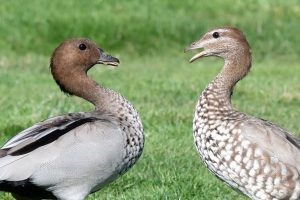
Chestnut Teals are a small duck with a round head, grey bill and red eyes. Chestnut Teals are ‘dabbling’ ducks that feed mainly on aquatic vegetation and insects, often by sticking their heads under the water to feed while sticking their rear ends and legs up out of the water! Males have a dark green head and “chestnut” brown body, while females are a darker brown overall with lighter brown feather edges and a paler throat and neck. Chestnut teals are closely related to Grey Teals and Pacific Black Ducks, and share similar traits like the brilliant shining (iridescent) wing panels that shine green to purple in flight. Chestnut teals live in pairs year round, and it’s common to find chestnut teals living in large flocks or just as a couple.
Similar to: Grey teal, male mallards (green heads).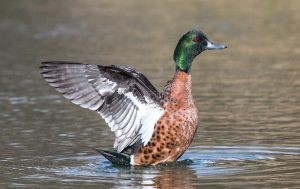
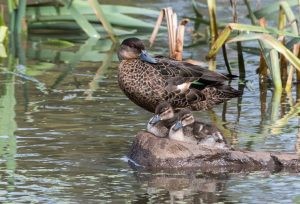
Grey Teals can be a challenge to spot, being very similar in appearance to their female Chestnut Teal relatives. Both males and females have dark brown/grey feathers with lighter cream-brown edges, pale throats and necks and red eyes. They are lighter overall than female chestnut teals, with white throats and necks and a grey-streaked brown face and head.
Grey Teals don’t stay in the same place year round like Chestnut Teals either. Instead, they cover great distances in search for fresh water sources when the old ones dry up. They can be found in coastal waterways and in the middle of the Australian desert, if that’s where the water is! They have even self-introduced themselves to New Zealand in search of water.
Similar to: Female Chestnut Teal
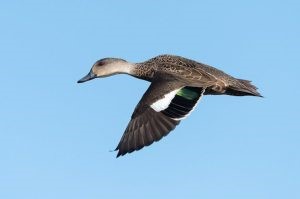
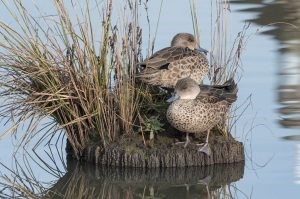
Despite the name, Pacific Black Ducks are actually mostly brown with cream coloured faces. But the “Pacific Dark Brown and cream duck” doesn’t have much of a ring to it! Pacific Black Ducks are an elegant dabbling duck, easily identified by two black stripes on the face that extend from the grey bill to the rear of the head. The “Pacific” part of the name comes from the fact that they can be found in many parts of the South Pacific including Tasmania. Despite being widespread they are not always common, and this is due to cross-breeding (hybridisation) with introduced mallard ducks. In some areas like Macquarie and Norfolk Islands and New Zealand, the problem is so widespread that native pacific back ducks have almost completely been replaced by mallard x pacific black duck hybrids. This is happening in parts of Tasmania like the Derwent Estuary, where most of the pacific black ducks are in fact mallard crosses. PBDs have a very short lifespan of only 2 to 3 years, so any PBDs you see are no older than a human toddler!
Pure Pacific Black Ducks can be identified by having two bold black stripes on the face, with a defined cream face patch in between them that extends from the slate-grey bill to the rear of the head. PBDs have thin cream/brown feather edges and dark grey/brown legs.
Similar to: Mallard x Pacific black duck hybrid
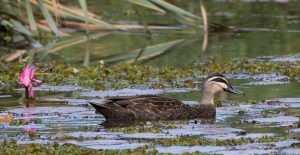
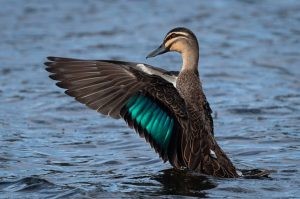
Shelducks are one of Tasmania’s bigger ducks and perhaps this is why they’re sometimes called “mountain ducks.” While they tower over smaller native ducks like teals and Pacific Black Ducks, they actually prefer to live in lowland areas as opposed to mountains and graze on green grass or aquatic vegetation and insects. Both males and females have black heads and necks, separated from a cinnamon brown breast by a white neck ring. The rest of the body is mostly black with white and green panels on the wings. You can tell females apart from the white rings around the eyes and the base of the bill. Interestingly, Shelducks are more common in Northern Tasmania, especially in green pastures, and much less frequently seen at dams or wetlands in the South. Shelducks like to build nests in large tree hollows or even rabbit burrows and are known to mate for life.
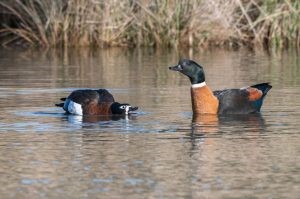
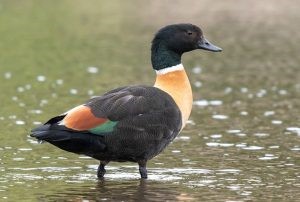
Australia’s most strangely-named duck. Rather than having a dense skull, the name “hardhead” comes from early taxidermists, who found the duck’s head the hardest part of the body to process. This was perhaps due to the striking white eyes, which are the reason why they used to be known as the “White-eyed duck.” This name didn’t stick due to only the males having the white eyes. Apart from the eyes, both males and females are similar. They are chocolate-brown with a large white patch under the tail and the grey bills have a unique blue tip. Hardheads can be hard to find in Tasmania as they are a bit fussier than other native ducks, preferring wetlands with plenty of vegetation for nesting and deep fresh water. They dive underwater for their food, mainly eating aquatic vegetation and animals like freshwater shellfish and mussels.
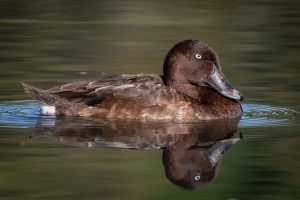
Compared to the Hardhead, this duck’s name is spot on! They’re most commonly found in wetlands in Southwest and Southeast Australia as well as New Zealand, and their massive bill is best described as a shovel attached to its face. This bill has small grooves along its edges that are used to filter insects, crustaceans and plants from water or soft mud while dabbling. Shovelers are a medium-sized duck that would be easily confused with a mallard or a pacific black duck x mallard hybrid if it weren’t for the massive bills. Males have bright orange legs and females have dark brown feathers with light brown feather edges like some mallards, as well as a think black stripe through the eye. Males however have bright yellow eyes, a dark grey/blue head with a white vertical stripe along the edge of the bill.
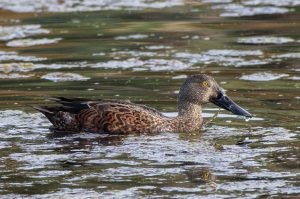
A contender for Australia’s strangest duck, they are also the biggest. Males are bigger than females, and the bulk of their body is submerged, making them look deceivingly small. This extra weight means they rarely fly and prefer to swim. They are diving-ducks and mainly feed on aquatic animals, such as insects, frogs, fish and crustaceans that they hunt for underwater. Musk ducks are black-brown overall with pale brown streaks. The bill is short and stubby and the tail is made up of long, stiff feathers. The males are easily identified by the large, leathery lobe of skin that hangs below the bill. Musk ducks get their name from their musky smell, but you’d have to be very close to one to be able to smell it!
Like many native ducks, they don’t quack. Musk ducks instead whistle and have even been known to learn other vocal noises when raised in captivity, mimicking other ducks and even humans! Something that no other duck in the world can do. Males use the stiff tail feathers during courtship displays, spreading them out like a fan or pointing them forwards over their back, while whistling, inflating the lobe under the bill and splashing the water with their feet. Musk ducks can live over 20 years, much longer than most other ducks.
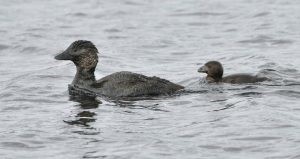
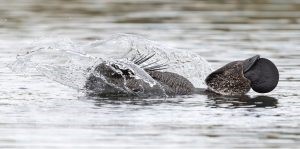
All Tasmanian ducks are excellent paddlers on water, but not many are as talented as blue-billed ducks under the surface. BBDs are a species of diving-duck, and feed on invertebrates and aquatic vegetation by diving deep in fresh water to find food in soft mud. This is different to the dabbling ducks, who find most of their food on or close to the surface. Diving ducks also spend all of their time in water, unlike other ducks that waddle on land. Male Blue-billed ducks are easy to identify. They are compact, with chestnut-brown bodies, dark heads and the namesake light-blue bill. Females are similar to female musk ducks and have grey-brown feathers with light brown bands and brown bills. The bill is the best way to tell them apart, as they are much longer than the stubby musk duck’s bill. The tail feathers of BBDs are stiff and pointy and help with diving. The tails are normally not seen as they lie flat on the water, but males point them vertically in the breeding season to attract females. Unfortunately, BBDs are ‘near threatened’ nationally and endangered in Victoria. They are rare visitor to Tasmania.
Similar to – Musk duck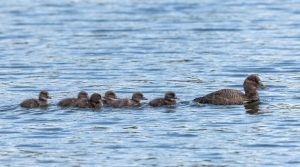
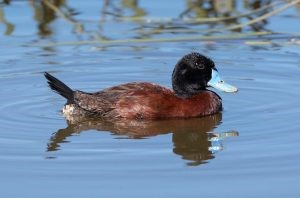
Freckled ducks are the rarest of all Australian ducks, and are an occasional visitor to Tasmania. They spend most of their time on mainland Australia in inland wetlands and disperse out towards coastal areas in the drier summer months. Freckled ducks don’t breed in Tasmania and mainly seem to come here to escape drought conditions elsewhere in Australia. This means that there can be years where there may be no freckled ducks visiting Tasmania at all, and others where many will congregate at dams and lakes around the state (Goulds Lagoon and Queechy Lake are favourite summer getaways).
Freckled ducks are dark brown overall with light brown to white “freckles” all over. The bills are very distinct, broad at the base and sloping down to a flat tip. The heads are large and peaked at the back. During the breeding season, the bills of males go bright red at the base. They mainly eat aquatic vegetation and insects.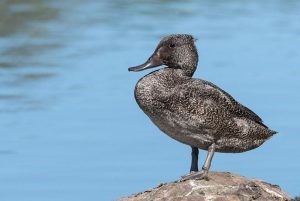
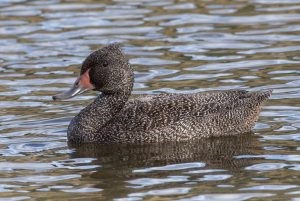
Pink-eared ducks are common throughout mainland Australia but a rare visitor in Tasmania. Like many native ducks, their favourite hang-outs include places like Goulds Lagoon and Queechy lake, but they can turn up at many freshwater lakes and dams around Tasmania. Pink-eared ducks are a small, strange-looking duck, easily identified by the dark-brown and white stripes that run from the head to the tail (this is why they’re also known as zebra ducks). They have a brown eye patch and a massive grey bill with a square tip. Their name comes from the small pink patch on the head behind the eye. Pink-eared ducks mainly feed on microscopic plants and animals. Their specialised bills are fringed with small lamellae (comb-like grooves), which helps them to filter this food out from fresh water. It’s believed that breeding pairs bond for life.
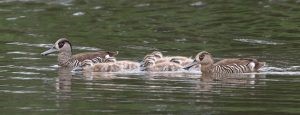
Mallards are an introduced species in Australia, New Zealand, many Pacific islands. They are native to Europe, Asia and North America and have been domesticated into many different breeds of domestic duck. Mallards were introduced to Australia in the 1860s and are now a combination of wild Mallards and domestic ducks, that have been crossbreeding since their arrival. They can look like wild mallards (think the duck emoji) or plain white domestic ducks. Indian Runners, Pekin, Swedish Blues and all other types of domestic farm ducks (apart from Muscovy Ducks) are just different breeds of mallards. Just like how different dog breeds are all the same species, all domestic ducks (apart from muscovy ducks) come from wild mallard ancestors.
Because mallards have been domesticated, they don’t have the same natural fear of humans that native ducks do, and thrive alongside humans as a result. Feeding ducks only supports mallards, because they aren’t as good at foraging for their own food, and most native ducks are too shy to come near people or don’t even eat the food that is being offered. Mallards are bigger and more aggressive than our native ducks, making them the bullies of the duck world. Mallards can live 5-10 years in the wild, sometimes as long as 20 years, which means each individual mallard can breed with many Pacific black ducks and pacific black duck x mallard hybrids in its lifetime.
To protect native ducks from mallards, it’s important to not feed or leave water out for ducks, as this only helps mallards to push out natives more.
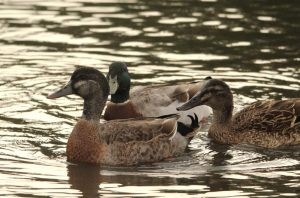
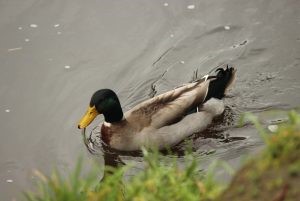
These hybrid ducks are the result of cross breeding (hybridisation) between introduced mallards and native Pacific Black Ducks. This is possible because despite being from different parts of the planet, mallards and Pacific Blacks are closely related. Pacific Black aren’t alone here and mallards are possibly the most common bird in the world to hybridise with different species (more than 40!), many of these other duck species around the world are also threatened as a result. Most hybrid birds aren’t able to reproduce. But the problem with mallard x PBD hybrids is that they can, and so can their offspring, and so on.
They can sometimes be very easy to identify, and other times very difficult. Hybrids can look like a perfect mix of both species and have traits from both sides, or they can look almost exactly like one or the other. The most common traits in hybrids are orange legs, yellow, orange or blotchy bills, brown feathers with large brown feather edge trims and darker faces. It is very common to see ducks that look like genetically pure Black Ducks, until they start dabbling and up-end themselves, showing off a pair of bright orange legs. Hybrids are a threat to Pacific Blacks, because they migrate much further from their birthplace than feral mallards do, bringing them into contact with more pure Black Ducks, making pure Black Ducks rarer over time. Hybrids are now unfortunately the most common duck species in many parts of Tasmania.
Tips for identifying mallard x PBD hybrids. Remember any combination of these traits can occur, and characteristics can vary:
- Bright Orange legs and feet
- Lighter brown feathers
- Orange, yellow or patchy bills, or varying bill colours from the usual slate-grey
- Pale facial stripes and/or very dark faces.
- Brown streaks through the crown (top of the head)
- Curled tail feathers
- White trims on either side of the speculum (green/blue wing panel).
- Any obvious mallard traits
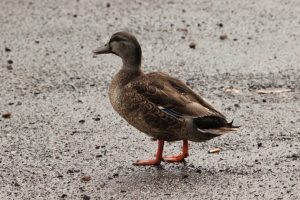
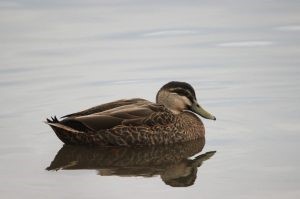
Another duck you might see around are feral domestic Muscovy ducks. These are very big ducks, bigger than their wild south American ancestors and males can weigh up to 8kg! Similar to domestic mallard ducks, they were domesticated for meat and eggs. Their colours can vary a lot, but they can always be identified by the red lumpy looking faces and massive size compared to native ducks. They are not as common in Australia as other feral ducks. Males can’t fly far due to their weight so they don’t disperse far from where they’ve escaped from or where they have been dumped. Feral Muscovy ducks can survive a long time due to their ability to eat everything: from plants, small fish, insects, frogs, small lizards and even mice!
Muscovy ducks make a great pet alternative to mallards! Instead of loud quacking they are very quiet and don’t quack at all. They have nowhere near the same level of impact as feral mallards, as they do not cross breed with any native species. They can cross breed with mallards, but don’t produce fertile offspring like mallard x pacific black ducks.
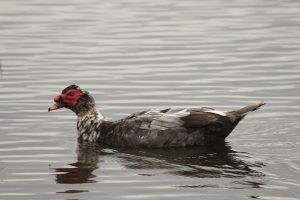
Photo credit: Helen Cunningham.